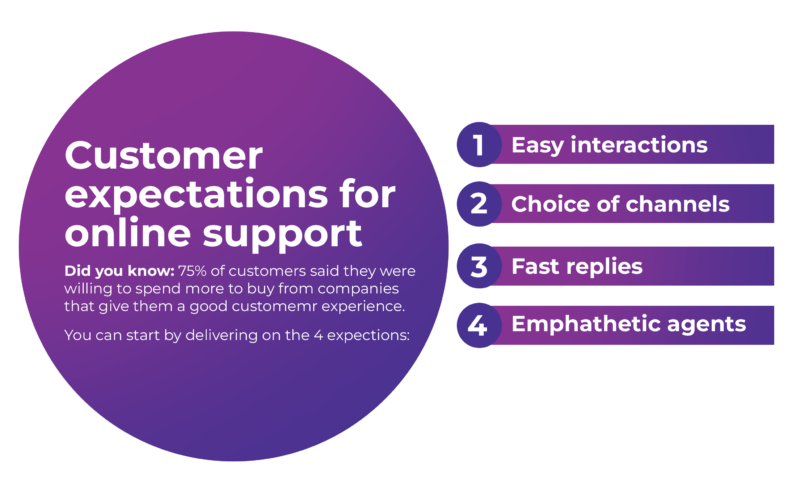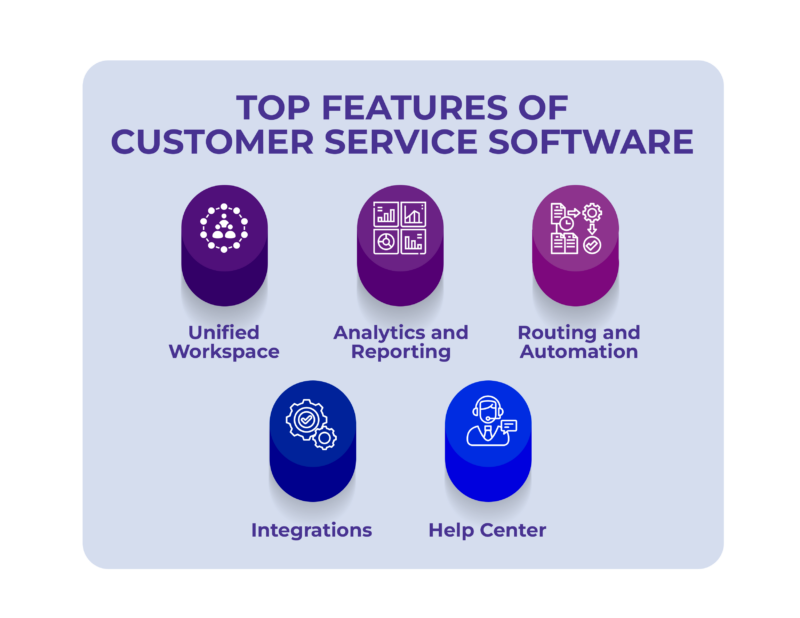Outsourcing website customer service refers to the practice of hiring an external company to manage various areas of customer service and assistance provided through the business website. Rather than handling customer inquiries internally, a company hires an external service provider to manage these tasks on its behalf.
With an increased emphasis on offering exceptional customer experiences online, many businesses have turned to outsource customer services, such as live chat, email assistance, and social media engagement. This article will discuss the benefits of outsourcing website customer service, steps for successfully outsourcing, factors to consider, common challenges of partnering with an external service provider, and ways to address them.
Benefits of Outsourcing Website Customer Service
As websites become many customers’ first point of contact, the need for responsive and excellent website customer service cannot be overstated. Because of this, outsourcing website customer service has emerged as a dynamic solution that offers many benefits. Here are some of its advantages:
Cost Savings
One of the main benefits of outsourcing website customer service is the potential significant savings. Partnering with an external service provider reduces the expenses of establishing and maintaining an in-house customer service team, including recruitment, training, salaries, benefits, technological infrastructure, and office space. This allows companies to allocate their resources more strategically, investing in growth initiatives while delivering good customer service experiences through the expertise of the outsourced team.
Improved Customer Satisfaction
Customer satisfaction is the foundation of any successful business, and outsourcing customer service tasks can contribute to achieving this. External service providers specializing in customer service understand the best practices, ensuring that each interaction is handled professionally. This results in faster issue resolution, accurate information dissemination, and customized help – all of which contribute to an excellent customer service experience.
Access to a Larger Pool of Talent
Outsourcing companies typically hire and train customer support representatives skilled at handling various customer interactions, from technical questions to complex problem-solving. This expertise enables companies to provide comprehensive and specialized assistance to their customers, resulting in faster issues resolution. The larger talent pool also brings a wealth of expertise, languages, cultural understanding, and specialized skills that improve the quality of customer support.
Improved efficiency
External customer service teams are often dedicated to handling customer concerns, allowing them to gain expertise and efficiency in dealing with various customer issues. This results in faster response times, which, in turn, leads to higher customer satisfaction.
Outsourcing also enables companies to leverage technologies and tools that streamline customer support services. These tools may include ticketing systems, knowledge bases, chatbots, and analytics platforms that help manage and track customer interactions, resulting in a well-organized and optimized workflow.
Steps for Outsourcing Website Customer Service
Define your customer service needs
- Assess your current customer service processes to identify pain points, bottlenecks, and areas for improvement.
- Determine your customer service goals, such as improving response times, enhancing customer satisfaction, reducing resolution times, or expanding support availability.
- Choose key performance indicators (KPIs) to assess the success of your customer service initiatives. First Response Times (FRT), Average Resolution Time (ART), Customer Satisfaction Score (CSAT), and Net Promoter Score (NPS) are common KPIs.
- Understand customers’ common paths when interacting with your website and seeking assistance. Determine the touchpoints where outsourcing can improve the customer experience.
- Establish your outsourcing budget, taking into account the cost of training, tools, monitoring, and ongoing support. When assessing the potential return on investment (ROI), consider both short-term and long-term expenses.
Research outsourcing options
- Start by compiling a list of customer service-oriented outsourcing providers. You can use online directories, industry associations, referrals, and search engines to find potential partners.
- Review each potential partner’s experience in customer service for websites and businesses like yours. Check online reviews and ratings for the outsourcing company you’re considering. Platforms such as Google and Yelp can provide insight into their reputation and the quality of their services.
- Inquire about the outsourcing partner’s tools for managing customer interactions. Ensure that their systems are compatible with your existing infrastructure and can integrate smoothly.
- Language proficiency and cultural knowledge are essential if your customer base spans different regions. Choose an outsourcing provider with agents who can interact effectively with diverse customers.
- Review the contract terms, including service level agreements (SLAs), response times, resolution times, and other performance indicators. Ensure they are aligned with your customer service objectives.
- Request a detailed proposal suited to your specific business needs from each shortlisted outsourcing partner. Compare the proposals to see which partner offers the most comprehensive and suitable solution.
Develop a clear communication plan
- Designate individuals within your organization who will be your outsourced partner’s primary contact. Ensure that they are accessible and responsive.
- Determine the main communication channels you’ll use with the customer service provider. This could include email, video conferencing, project management tools, chat platforms, and phone calls.
- Establish a regular meeting schedule for progress reports, performance reviews, and strategic discussions.
- Create a playbook outlining communication protocols, expected response times, escalation procedures, and troubleshooting guidelines. This serves as a reference for both teams.
- Review and evaluate the communication plan’s effectiveness regularly. Make changes in response to feedback, performance metrics, and changing business needs.
Implement and monitor the outsourcing process
- Start by onboarding the outsourced partner’s agents. Provide comprehensive training on your company’s products, services, brand voice, communication guidelines, and customer service processes. Share documentation, FAQs, troubleshooting guides, and other useful documentation to ensure a smooth knowledge transfer.
- Integrate the tools and systems of your outsourced partner with your existing infrastructure. Ensure they have access to your CRM, ticketing system, communication platforms, and other tools required for their role.
- Conduct a kickoff meeting to introduce your internal customer service department to the outsourcing team. Clarify roles, responsibilities, communication channels, and expectations for collaboration.
- Schedule regular performance review sessions to discuss progress, address challenges, and celebrate successes. Use these meetings to provide feedback and make necessary adjustments.
- Implement a rewards and recognition program to motivate and recognize the efforts and achievements of the external team.
- Embrace a culture of continuous improvement by consistently analyzing processes, gathering feedback, and making improvements to optimize the outsourcing relationship.
Factors to Consider When Outsourcing Website Customer Service
Quality of Services

When considering outsourcing website customer service, the outsourcing partner’s quality of services is critical. The expertise of customer service agents, adherence to brand guidelines, and consistent, transparent communication are key factors representing the overall quality of outsourcing services. It’s essential to assess the outsourcing partner’s commitment to continuous improvement. Metrics like customer satisfaction, their handling of escalations, and cultural sensitivity are important in establishing service quality.
Availability and accessibility
The ability of the remote customer service team to provide service around the clock or during your needed operational hours directly affects customer satisfaction. A seamless integration of various channels, such as live chat, email, or phone, guarantees customers can seek support through their preferred channel. Additionally, time zone compatibility with your target audience is required to deliver timely responses. The outsourcing partner’s ability to quickly expand resources during peak periods improves their accessibility.
Cost
A transparent pricing structure that suits your budget and business goals should be a top concern. Consider hourly rates, extra fees for specialized support, and potential return on investment. Evaluating the outsourcing partner’s ability to provide flexible pricing options and customized packages can help you save costs. It is essential to note that while cost-effectiveness is desired, it is critical to balance affordability and the level of service delivered.
Cultural Compatibility
The quality of customer interactions can be improved by working with a partner who understands and respects the cultural differences of your target audience. Having customer service representatives who can effectively communicate and sympathize with customers from various cultural backgrounds promotes a positive and relatable experience. Cultural compatibility includes language proficiency, familiarity with local traditions, and understanding of cultural sensitivities. Choosing a customer service outsourcing provider who shares your brand’s cultural values and can authentically connect with your customers can help build stronger relationships, reduce miscommunication, and improve the overall quality of customer support on your website.
Tips for Successful Outsourced Website Customer Service
Foster Open and Clear Communication
Create definite expectations regarding communication channels, response times, issue resolution processes, and performance metrics at the outset. The expectations should be clear to both the internal and the outsourced workforce. Encourage the outsourced team to share their experiences and challenges through feedback. This two-way communication helps streamline procedures and foster teamwork.
Maintain a consistent brand voice
Define your brand’s voice, tone, and messaging guidelines in detail. This includes your brand’s communication style, language preferences, and overall personality. Share these guidelines with your outsourced partner so they can effectively replicate your brand’s voice. Incorporate training as part of their onboarding process.
Set up a quality assurance process and monitoring of customer interactions. Regularly reviewing chats, emails, and other communications can help identify deviations from the established brand voice.
Use Technology to Your Advantage

Source
Implement a CRM to track customer interactions, manage queries, and maintain customer data. This helps in providing personalized support. Ticketing systems and help desk platforms help organize and prioritize customer concerns and ensure they are dealt with quickly and efficiently. Integrate live chat capabilities onto your website to provide real-time assistance. Chatbots can handle routine inquiries, allowing human agents to focus on more complex issues. Additionally, automated workflows for routine tasks help reduce manual workload and increase productivity.
Continuously evaluate and improve the outsourcing process
Define measurable KPIs that reflect the effectiveness of your outsourced website customer service. Analyze these metrics, review individual agent performance, and provide feedback to find areas of improvement. Invest in skill development for the outsourced team. This ensures they are updated with the company’s services and customer service best practices.
Lastly, recognize and celebrate victories gained through continual improvement efforts. This increases morale and inspires continued dedication to excellence.
Potential Challenges of Outsourcing Website Customer Service and How to Overcome Them
Language Barriers
Effective communication is critical for providing a positive customer experience, and language barriers can lead to misunderstandings and poor customer service. Customers may feel dissatisfied if they cannot receive responses that address their concerns. Furthermore, poorly communicated messages can negatively impact your brand’s image and reputation, potentially losing customer trust. Here are some ways to overcome language barriers:
- Before hiring customer service representatives, evaluate their language skills through written and verbal assessments. Check to see if their communication abilities fit your expectations.
- Provide extensive training to the customer support agent focusing on language fluency, cultural awareness, and effective communication skills.
- Develop standardized templates and guidelines for handling common customer inquiries.
- Assess the quality of customer interactions regularly, focusing on language accuracy and customer satisfaction. Use these to identify training needs and to improve processes.
Time Differences
When outsourcing website customer service, dealing with time zone differences can be challenging. Providing seamless customer service across multiple time zones requires careful planning. Here are some strategies to deal with time differences:
- Distribute your support team strategically across several time zones to ensure coverage during peak customer hours. This may entail having teams from several regions manage different shifts.
- Use a “follow-the-sun” strategy in which teams hand over tasks to peers in other time zones as their workday ends. This ensures that there are no delays in providing service.
- Choose an outsourcing partner who has managed multinational teams and time zone challenges. They should have procedures in place to ensure smooth coordination.
- Regularly evaluate the efficiency of your time zone management strategy and make adjustments based on customer feedback and performance metrics.
Maintaining Control Over the Customer Experience
Maintaining control over the customer experience is a common concern of many businesses when outsourcing customer service. Businesses want to maintain their brand’s values, standards, and quality even when dealing with customers through an external party. Below are some tips to address this challenge:
- Provide thorough training on your brand’s values, culture, and customer service standards to outsourced agents. This covers not only product knowledge but also communication guidelines. Create comprehensive guidelines, scripts, and templates for various customer scenarios.
- Implement a strong quality assurance process in which interactions are monitored and reviewed regularly. Provide feedback and coaching to improve performance.
- Establish procedures for escalating complex or sensitive issues to internal teams. This ensures that critical matters are dealt with appropriately without compromising customer experience.
- Treat the outsourced customer service team as an extension of your business. Promote a collaborative relationship where people feel appreciated and connected to your brand’s mission.
Outsourcing website customer service allows companies to improve their online presence and customer satisfaction while maximizing resource allocation. Choosing to outsource customer service enables them to tap into a pool of professionals adept at handling customer inquiries, technical issues, and support requests. This technique not only allows businesses to streamline their processes but also enables them to provide round-the-clock support, fostering a positive customer experience.
For an outsourcing partnership to be successful, factors such as quality of services, availability and accessibility, cost, and cultural compatibility must be considered. With careful consideration of these factors and a well-defined strategy, outsourcing can prove to be a wise investment for businesses seeking to thrive in a competitive digital environment.



Leave A Comment Cancel reply
You must be logged in to post a comment.